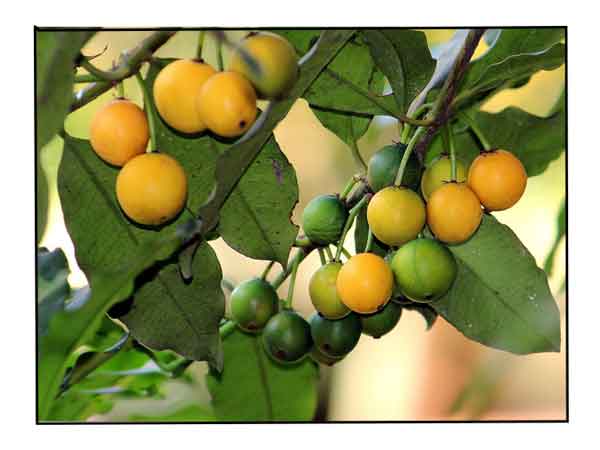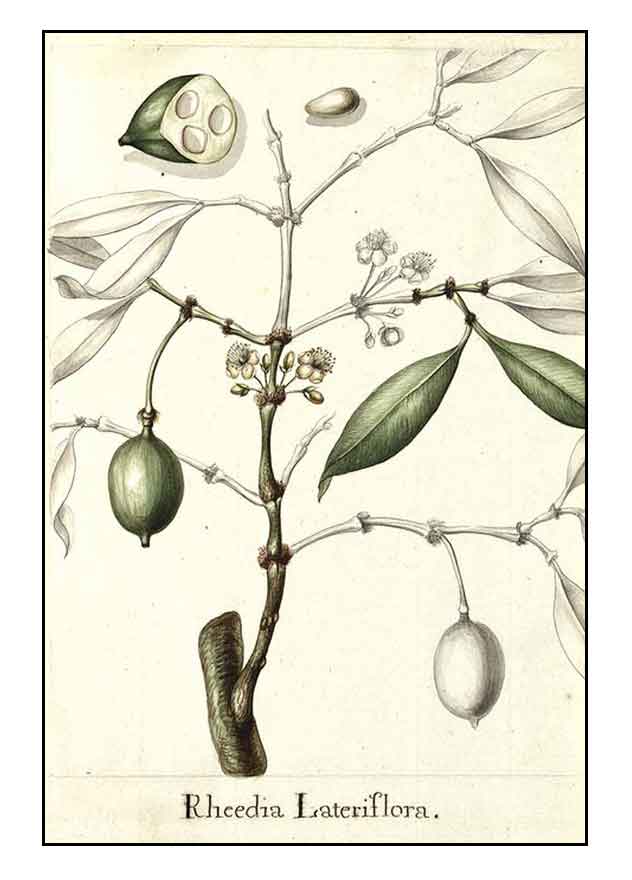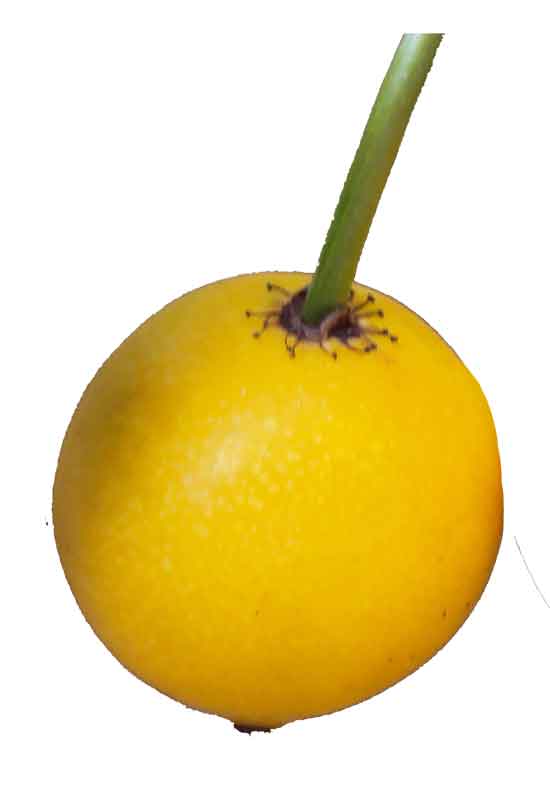 Gen info Gen info
-
Garcinia is a genus of flowering plants in the family Clusiaceae. The number of species is disputed. Plants of the World Online recognizes up to 400 species. The plants in the genus are called saptrees, mangosteens, or garcinias.
- The genus name Garcinia honors the French botanist Laurent Garcin (1683-1751). (10)
Botany
Berba is a fast growing tree reaching a height of about 5 m with a straight, slim trunk supporting a densely branched pyramidal crown. Bark is dark brown, smooth, which exudes a sticky yellowish sap when wounded. Leaves are opposite, short-petioled, thick, leathery, elliptic or elliptic-lanceolate, 8-15 cm long and 1-5 cm wide, or larger, with numerous lateral veins, conspicuous on both surfaces, bright red when young, becoming dark green above, pale green or brownish on the underside. Flowers are small, greenish white or ivory colored, densely clustered below the leaves, 4-petaled, the male with 25-30 stamens; female flowers are solitary or occasionally in clusters. Fruit is oval or oblong, 2-3.2 cm long, smooth, orange or yellow, with thin and easily peeled skin; one- or two-seeded with a white edible but scant pulp, with an appealing sweet and sour flavor.
 Distribution Distribution
- Introduced.
- Native range is Central Mexico to Ecuador.
- Cultivated sporadically throughout the tropics.
- Propagated by seeds; can be grafted.
Constituents
- Study of leaves yielded active components, the polyisoprenylated benzophenone derivative guttiferone A and the xanthone 8-desoxygartanin with biflavonoids podocarpusflavone A and amentoflavone, and friedelin. (3)
- Study of fruits yielded guttiferone A, gutti8feronne E, xanthochymol, Fukugetin, volkensiflavone, and fukugeside. (see study below) (4)
- Guttiferone A, 8-desoxygartanin, podoscarpusflavone A, amentoflavone, and friedelin have bee identified in the leaves.
- Study performed metabolomics profiling of G. intermedia leaves using three drying method treatments: air-dried (room temperature), freeze-drying, and oven (hot air) through GC-MS. Results identified a total of 35 compounds. The highest area pct was Friedelan-3-onne (29.92%) form air-dried method. Other compounds were sesquiterpenes group (beta-Caryophyllene, gamma-Muurolene, Naphthalene,1,2,3,5,6,8a-hexahydro-4,7-dimethyl-1- (1-methylethyl)-,(1S-cis)-, and 1-Isopropyl-4,7-dimethyl-1,2,3,5,6,8a-hexahydronaphthalene); alkane group (Octadecane and Heptacosane) and vitamin E (delta-Tocopherol and dl-alpha-Tocopherol). (12)
- Study of seeds and rinds of Rheedia edulis identified two new polyisoprenylated benzophenones, 32-hydroxy-ent-guttiferone M (1) and 6-epi-guttiferone J (2), along with seven known compounds, 6-epi-clusianone (3), guttiferone A (4), xanthochymol (5), guttiferone E (6), isoxanthochymol (7), (+)-volkensiflavone (8), and (+)-morelloflavone (9). (see study below) (14)
Properties
- Fruiting may occur in as early as two years.
- Studies have suggested antioxidant, antiproliferative, trypanocidal properties.
 Parts used Parts used
Fruits, leaves.
Uses
Edibility
- Fruit is edible; usually eaten out of hand with an appealing sweet and sour taste.
- Fruit can be used for making jams, jellies, and drinks.
Folkloric
- In Benguet, Cordillera administrative region, fruit use in the treatment of flu. (9)
Others
- Wood: Termite resistant. Used for light construction, making fence posts, tool handles and temporary railroad ties. Bark is rich in tannin.
Studies
• Phytoconstituents / Trypanocidal Activity / Leaves: Study evaluated the leaves of Garcinia intermedia and heartwood of Calophyllum brasiliense for phytoconstituents based on their trypanocidal activity against epimastigotes of Trypanosoma cruzi, the etiologic agent for Chagas disease. Garcinia intermedia yielded active components, the polyisoprenylated benzophenone derivative guttiferone A and the xanthone 8-desoxygartanin with biflavonoids podocarpusflavone A and amentoflavone, and friedelin. (3)
• Antioxidant / Antiproliferative Against Colon Cancer Cells / Fruits: Study of fruits yielded guttiferone A, guttiferonne E, xanthochymol, Fukugetin, volkensiflavone, and fukugeside. The antioxidant activity of guttiferone A on DPPH assay showed an IC50 of 46 µM. The antiproliferative effect of guttiferone against colon cancer cells (HT-29) was IC50 15.8 µM. (4)
• Garcinia Benzophenones / Inhibition of Human Colon Cancer Cells / Synergism with Sulindac and Turmeric: Previous studies have showed extracts and purified components from Garcinia species inhibit the growth of human colon cancer cells. Garcinia benzophenones activate the expression of genes in the endoplastic reticulum and cellular energy stress (mTOR) pathways. Study evaluated the growth inhibitory and synergistic effects of Garcinia benzophenones, alone or combined with chemopreventive agents, on human colon cancer cells. New and known benzophenones from G. intermedia inhibited the growth of human colon cancer cells. Studies indicate the potential of benzophenones, alone or combined with sulindac sulfide or turmeric, to prevent and treat colon cancer. (6)
• Benzophenones and Biflavonoids / Antioxidant / Fruits: A methanol extract exhibited low antioxidant activity (IC50=118.1 ±0.94 µg/mL) in DPPH assay. The chloroform and ethyl acetate partition exhibited high activity, (23.4±1.28 µg/ml and 41.4±3.66 µg/ml respectively. The n-butanol partition showed moderate activity (68.0 ± 1.41 µg/ml). Guttiferone E, isoxanthochymol, fukugetin and volkensflavone have been previously isolated. The antioxidant activity of these compounds have previously been reported, except for guttiferone A with IC50=46 µM, which is comparable to gallic acid (IC50=35µM). (7)
• Metabolomic Profile of Leaves with Drying Methods: Study performed metabolomics profiling of G. intermedia leaves using three drying method treatments: air-dried (room temperature), freeze-drying, and oven (hot air) through GC-MS. Results provide insight into potential uses of leaves extract with additional functional metabolites to use in the study of potential drugs to benefit human health. (see constituents above) (12)
• Antioxidant Activity: HPLC-PDA study evaluated eight Garcinia species including seven edible fruits: Garcinia aristata, G. hombroniana, G. intermedia, G. livingstonei, the "superfruit" G. mangostana, G. spicata, and G. xanthocymus, and the wood of G. kola. Garcinia intermedia and G. mangostana demonstrated high antioxidant activity with IC50s of 60.1 µg/mL and 64.3 µg/mL respectively. Garcinia intermedia yielded highest quantity of guttiferone A, determined to be rich in total phenolic content. (13)
• Benzophenones and Biflavonoids / Antioxidant / Seeds and Rind: Study of seeds and rinds of Rheedia edulis identified two new polyisoprenylated benzophenones, 32-hydroxy-ent-guttiferone M (1) and 6-epi-guttiferone J (2), along with seven known compounds. Compound 1 showed significant antioxidant activity in both DPPH and ABTS free radical scavenging assays. (see constituents above) (14)
Availability
Wildcrafted.
Cultivated. |

![]()




 Distribution
Distribution
